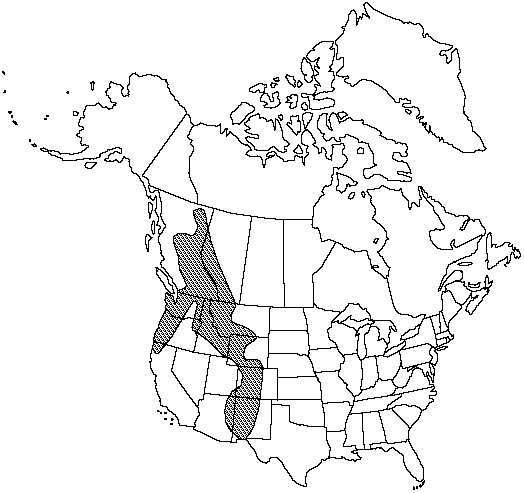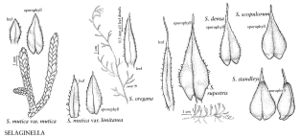Difference between revisions of "Selaginella scopulorum"
Amer. Fern J. 11: 36. 1921.
FNA>Volume Importer |
FNA>Volume Importer |
||
| Line 22: | Line 22: | ||
}}<!-- | }}<!-- | ||
| − | --><span class="statement" id="st- | + | --><span class="statement" id="st-undefined" data-properties=""><b>Plants </b>terrestrial or on rock, forming cushionlike or rather loose mats. <b>Stems</b> decumbent or creeping, not readily fragmenting, irregularly forked, without budlike arrested branches, tips straight; main stem upperside and underside structurally slightly different, conspicuously or inconspicuously indeterminate, lateral branches radially symmetric, conspicuously determinate, strongly ascending, 1–2-forked. <b>Rhizophores</b> borne on upperside of stems, throughout stem length, 0.25–0.45 mm diam. <b>Leaves</b> monomorphic, in poorly defined pseudowhorls of 4 or 6, tightly appressed, ascending, green, linear-lanceolate to linear, in lateral ranks sometimes falcate, 2.5–4(–4.3) X 0.5–0.75 mm (upperside leaves smaller than underside, smaller also on ascending buds); abaxial ridges present; base (on main stem) decurrent, oblique, and glabrous on underside leaves, slightly decurrent to adnate, oblique, and glabrous or rarely puberulent on upperside leaves; margins usually short-ciliate, cilia transparent, spreading or ascending at base, denticulate and ascending on distal 2/3, 0.02–0.07(–0.15) mm; apex plane or sometimes slightly keeled, obtuse to attenuate, abruptly bristled; bristle whitish, transparent to opaque, with few teeth or smooth, 0.5–1.1 mm. <b>Strobili</b> solitary, (0.5–)1–3(–4.5) cm; sporophylls ovate-lanceolate, lanceolate, or seldom ovate, usually tapering toward apex, abaxial ridges well defined, base glabrous, margins proximally short-ciliate to denticulate, lacking cilia apically, apex usually attenuate or slightly keeled, short-bristled.</span><!-- |
-->{{Treatment/Body | -->{{Treatment/Body | ||
| Line 52: | Line 52: | ||
|publication year=1921 | |publication year=1921 | ||
|special status= | |special status= | ||
| − | |source xml=https://jpend@bitbucket.org/aafc-mbb/fna- | + | |source xml=https://jpend@bitbucket.org/aafc-mbb/fna-data-curation.git/src/9216fc802291cd3df363fd52122300479582ede7/coarse_grained_fna_xml/V2/V2_545.xml |
|genus=Selaginella | |genus=Selaginella | ||
|subgenus=Selaginella subg. Tetragonostachys | |subgenus=Selaginella subg. Tetragonostachys | ||
|species=Selaginella scopulorum | |species=Selaginella scopulorum | ||
| − | |||
| − | |||
| − | |||
| − | |||
| − | |||
| − | |||
| − | |||
| − | |||
| − | |||
| − | |||
| − | |||
| − | |||
| − | |||
| − | |||
| − | |||
| − | |||
| − | |||
| − | |||
| − | |||
| − | |||
| − | |||
| − | |||
| − | |||
| − | |||
| − | |||
| − | |||
| − | |||
| − | |||
| − | |||
| − | |||
| − | |||
| − | |||
| − | |||
| − | |||
| − | |||
| − | |||
| − | |||
| − | |||
| − | |||
| − | |||
| − | |||
| − | |||
| − | |||
| − | |||
| − | |||
| − | |||
| − | |||
}}<!-- | }}<!-- | ||
-->[[Category:Treatment]][[Category:Selaginella subg. Tetragonostachys]] | -->[[Category:Treatment]][[Category:Selaginella subg. Tetragonostachys]] | ||
Revision as of 13:23, 27 July 2019
Plants terrestrial or on rock, forming cushionlike or rather loose mats. Stems decumbent or creeping, not readily fragmenting, irregularly forked, without budlike arrested branches, tips straight; main stem upperside and underside structurally slightly different, conspicuously or inconspicuously indeterminate, lateral branches radially symmetric, conspicuously determinate, strongly ascending, 1–2-forked. Rhizophores borne on upperside of stems, throughout stem length, 0.25–0.45 mm diam. Leaves monomorphic, in poorly defined pseudowhorls of 4 or 6, tightly appressed, ascending, green, linear-lanceolate to linear, in lateral ranks sometimes falcate, 2.5–4(–4.3) X 0.5–0.75 mm (upperside leaves smaller than underside, smaller also on ascending buds); abaxial ridges present; base (on main stem) decurrent, oblique, and glabrous on underside leaves, slightly decurrent to adnate, oblique, and glabrous or rarely puberulent on upperside leaves; margins usually short-ciliate, cilia transparent, spreading or ascending at base, denticulate and ascending on distal 2/3, 0.02–0.07(–0.15) mm; apex plane or sometimes slightly keeled, obtuse to attenuate, abruptly bristled; bristle whitish, transparent to opaque, with few teeth or smooth, 0.5–1.1 mm. Strobili solitary, (0.5–)1–3(–4.5) cm; sporophylls ovate-lanceolate, lanceolate, or seldom ovate, usually tapering toward apex, abaxial ridges well defined, base glabrous, margins proximally short-ciliate to denticulate, lacking cilia apically, apex usually attenuate or slightly keeled, short-bristled.
Habitat: Rocky alpine tundra, subalpine meadows, dry cliffs, rocky slopes, rock crevices, granitic outcrops and ledges, sandstone outcrops, in soil pockets among rocks, or sandy or granitic soil
Elevation: 700–3700 m
Distribution

Alta., B.C., Ariz., Calif., Colo., Idaho, Mont., N.Mex., Oreg., Utah, Wash., Wyo.
Discussion
Selaginella scopulorum is a member of the S. densa
complex, in which there is a clear need for more systematic studies. Some specimens of S. scopulorum from Montana, Wyoming, and Colorado have more conspicuous whitish bristles than those elsewhere and are difficult to distinguish from S. densa.
Selected References
None.
